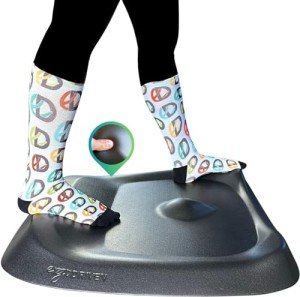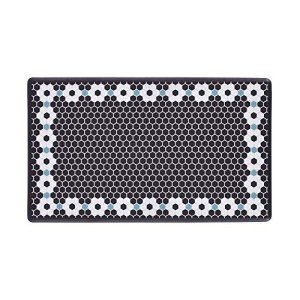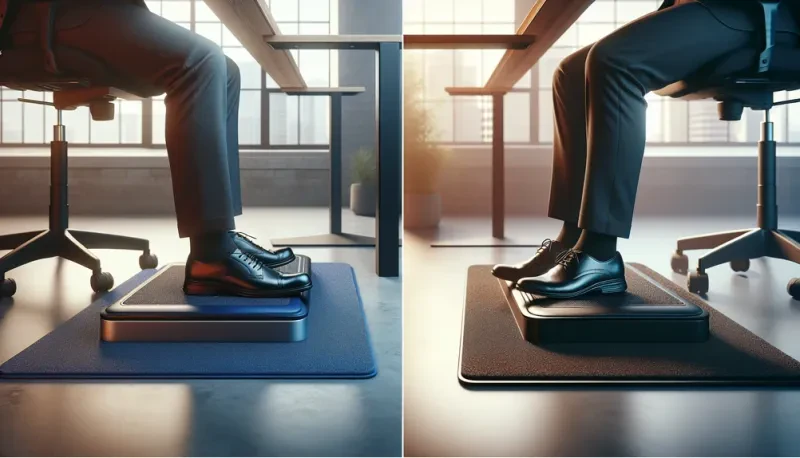In recent years, the benefits of a standing desk have gained significant attention in the workplace. This innovative approach to office furniture has caused a revolution in how people view their work environment and personal health. Standing desks offer a range of advantages, from improved ergonomics to increased vitality, making them a popular choice for those looking to enhance their daily work routine.
The standing desk trend has an impact on various aspects of work life. It contributes to better posture and reduced back pain, potentially leading to long-term health benefits. Additionally, many users report higher energy levels and improved productivity when using a standing desk. To top it all off, standing while working benefits individuals by burning more calories throughout the day, which can help with weight management. This article dives into these perks and provides tips to set up an ergonomic standing workspace.
Improved Posture and Reduced Back Pain
Standing desks have gained popularity due to their potential to alleviate back pain and improve posture. Many individuals who spend long hours at a desk experience discomfort in their back, neck, and shoulders. The benefits of a standing desk include the opportunity to reduce these issues by promoting better alignment and decreasing pressure on the spine.
Proper Alignment
When using a standing desk, it's crucial to maintain proper posture to maximize its benefits. Users should stand with their head back and hips upright, creating an 'S' curve in the spine. This alignment helps distribute weight evenly across the body, reducing strain on specific muscle groups. To achieve optimal ergonomics, individuals should position their computer monitor at eye level, about 20-28 inches from their face, with a slight 20-degree tilt [1]. This setup minimizes neck strain and promotes a more natural posture.
Reduced Pressure on Spine
One of the primary advantages of standing while working is the decreased pressure on the spine compared to sitting for extended periods. Prolonged sitting can compress the disks in the spine, leading to stiffness and discomfort. Standing intermittently in a neutral posture helps distribute pressure more evenly across muscles, ligaments, and spinal disks [2]. This redistribution can significantly reduce the risk of developing chronic back pain.
Decreased Muscle Tension
Standing desks encourage movement and frequent position changes, which can help alleviate muscle tension. When individuals alternate between sitting and standing throughout the day, they engage different muscle groups and promote better blood circulation. This variation in posture and movement can help reduce the risk of muscle imbalances and associated pain [3].
It's important to note that while standing desks offer numerous benefits, they are not a cure-all for back pain. Users should gradually acclimate to standing for longer periods, starting with short intervals and gradually increasing duration. Wearing comfortable, supportive shoes or using an anti-fatigue mat can provide additional comfort and support while standing [2].
To maximize the benefits of a standing desk, users should pay attention to their posture throughout the day. This includes keeping feet shoulder-width apart, engaging core muscles, and avoiding leaning to one side [3]. Additionally, taking regular breaks to walk around or stretch can further enhance the positive effects of using a standing desk.
While the benefits of standing desks are promising, it's essential to approach their use as part of a comprehensive strategy for managing back pain and improving overall health. Combining the use of a standing desk with other ergonomic practices and regular physical activity can lead to significant improvements in posture and reduced back pain over time.
Increased Energy and Productivity
Standing desks have gained popularity due to their potential to boost energy levels and enhance productivity in the workplace. This innovative approach to office furniture has caused a revolution in how people view their work environment and personal well-being.
Better Blood Flow
One of the primary benefits of a standing desk is improved blood circulation. When individuals stand while working, they promote better blood flow throughout their body, including to the brain. This increased circulation has a positive impact on overall energy levels and alertness. Standing encourages subtle movements and weight shifts, which can help stimulate blood flow and oxygen delivery to various parts of the body [4].
The improved circulation associated with standing desks can lead to a more energized feeling throughout the workday. Many users report feeling more awake and alert when using a standing desk compared to sitting for long periods. This heightened state of alertness can contribute to increased productivity and a more efficient workday [5].
Improved Focus
Standing desks have shown promising results in enhancing focus and concentration. Research conducted at Texas A&M University found that standing desk users experienced increased engagement and arousal compared to those using traditional sitting desks [6]. This improvement in focus is particularly beneficial for students and professionals who require sustained attention for their tasks.
The connection between standing and improved cognitive function is supported by scientific evidence. A study involving first-year high school students revealed that those using standing desks showed improvements in executive function and working memory capabilities [7]. These cognitive enhancements can translate into better problem-solving skills and increased productivity in various work environments.
Enhanced Mood
Standing desks have a positive influence on mood and overall well-being. A 7-week study found that participants using standing desks reported less stress and fatigue compared to those who remained seated throughout the workday [8]. Additionally, 87% of individuals using standing desks experienced increased vigor and energy throughout the day [9].
The mood-enhancing effects of standing desks are attributed to various factors. Standing activates more muscles and nerves than sitting, potentially increasing the production and release of endorphins, which are natural mood enhancers [8]. Furthermore, standing can increase the production of dopamine and serotonin, neurotransmitters that regulate mood, motivation, and pleasure [8].
The combination of improved blood flow, enhanced focus, and elevated mood contributes to a more productive work environment. By incorporating standing desks into their workspace, individuals can experience increased energy levels, better concentration, and a more positive outlook throughout the day. These benefits collectively lead to improved work performance and overall job satisfaction.
Calorie Burning and Weight Management
Standing desks have gained attention for their potential to contribute to weight management and calorie burning. While they are not a miracle solution for weight loss, they offer several benefits that can support a healthier lifestyle.
Increased Metabolic Rate
One of the primary advantages of using a standing desk is its ability to boost metabolic rate. When individuals stand while working, they engage more muscles and increase their overall activity level compared to sitting. This increased activity has a positive impact on metabolism, helping the body burn more calories throughout the day.
Research has shown that standing at work can lead to burning an additional 170 calories per day compared to sitting [10]. While this may seem modest, it can add up over time. In fact, the effects of standing extend beyond the time spent at the desk. The thermogenesis caused by non-exercise activity keeps the body's metabolism elevated day and night, potentially leading to burning as many as 2000 extra calories in a 24-hour period [10].
Combating Sedentary Lifestyle
Standing desks play a crucial role in combating the negative effects of a sedentary lifestyle. Prolonged sitting has been linked to various health issues, including obesity and metabolic diseases. By incorporating standing into the workday, individuals can reduce their sedentary time and improve their overall health.
The benefits of standing extend beyond mere calorie burning. Standing after meals has been shown to help regulate blood sugar levels more effectively. An Australian study found that alternating between sitting and standing every 30 minutes improved glucose levels by 11% in just one week [10]. This improvement in blood sugar regulation can have long-term positive effects on metabolic health.
Long-term Health Benefits
While the immediate calorie-burning effects of standing desks are noteworthy, the long-term health benefits are equally significant. Regular use of a standing desk can contribute to improved cardiovascular health, reduced risk of obesity, and better overall well-being.
Standing while working activates important enzymes in the body, such as Lipoprotein Lipase (LPL), which plays a crucial role in fat metabolism. LPL activity increases significantly with standing and non-exercise activity, while sitting can decrease its activity by up to 90-95% [10]. This means that standing desks not only help burn calories but also support the body's natural fat-burning processes.
It's important to note that while standing desks offer numerous benefits, they should be part of a comprehensive approach to health and weight management. Combining the use of a standing desk with regular physical activity and a balanced diet can lead to more significant and sustainable results in terms of weight management and overall health.
Ergonomic Setup Tips
To maximize the benefits of a standing desk, it's crucial to set it up correctly. Proper ergonomics can enhance comfort, reduce strain, and boost productivity. Here are some essential tips to ensure an optimal standing desk setup:
Proper Desk Height
The height of your standing desk plays a vital role in maintaining good posture and preventing discomfort. To find the ideal height, consider the following:
• Position the desk surface at or slightly below elbow height. This allows for a 90-degree angle at the elbows when typing or using the mouse [11].
• Adjust the desk height so that your arms and wrists are in a comfortable position, helping to prevent strain [12].
• If you're using an anti-fatigue mat, remember that it can raise your standing height by 1.6 to 2.4 inches. Take this into account when adjusting your desk [11].
Monitor Positioning
Correct monitor placement is essential for reducing neck and eye strain while standing. Follow these guidelines:
• Place the top of your monitor at or slightly below eye level. This helps maintain a neutral neck position and prevents slouching [12].
• Position the monitor about an arm's length away from your eyes. For larger screens, increase the viewing distance accordingly [12].
• If you wear bifocals, consider lowering the monitor slightly below eye level and tilting it upward at a 30 to 45-degree angle [12].
• To reduce glare, adjust the screen position and tilt it back 10 to 20 degrees [12].
Keyboard and Mouse Placement
Proper positioning of your keyboard and mouse is crucial for maintaining comfort and preventing repetitive strain injuries:
• Keep the keyboard and mouse at the same height, positioned in a straight line with your elbows, wrists, and hands [13].
• Place the keyboard flat on the desk surface, allowing your wrists to remain straight and in line with your hands and forearms [13].
• Position the mouse close to the keyboard to minimize shoulder strain and reduce reach [13].
• Avoid using wrist rests for mousing, as they can encourage pivoting of the wrist and increase joint strain [13].
By implementing these ergonomic setup tips, you can enhance the benefits of your standing desk and create a more comfortable and productive work environment. Remember to make adjustments throughout the day as needed, and alternate between sitting and standing to maintain optimal comfort and health benefits.
Conclusion
Standing desks have made a big splash in how we think about our work setup and health. They help us stand up straighter, feel more energized, and even burn a few extra calories while we work. What's more, these desks can make us more focused and in a better mood, which means we get more done during the day.
To get the most out of a standing desk, it's key to set it up right. This means putting your screen at the right height, making sure your keyboard and mouse are in a good spot, and changing between sitting and standing throughout the day. By doing this, you can create a workspace that's not only comfy but also helps you stay healthy and productive in the long run.
FAQs
Can standing desks enhance productivity?
Standing desks may enhance productivity by increasing brain activity due to improved blood flow, similar to the effects of exercise. Additionally, standing and moving might activate different brain areas than sitting, potentially boosting focus and problem-solving capabilities.
What are the health benefits of using a standing desk?
Standing desks can help lower blood sugar and cholesterol levels, which are linked to a reduced risk of heart disease, according to research reviewed by the Mayo Clinic.
What psychological advantages do standing desks offer?
Standing desks can lead to improved mood, increased productivity, and reduced stress. They may not be ideal for everyone, but for those looking to boost mental health and job performance, standing desks can be beneficial.
What is the recommended duration for standing at a standing desk?
It is suggested to stand for one hour for every one to two hours spent sitting. Many high-quality sit-stand desks are equipped with electric controls or gas lifts, allowing users to adjust their desk height multiple times throughout the day to achieve this balance.
References
[1] - https://www.vari.com/resource-center-articles/rc-top-standing-desk-mistakes.html?srsltid=AfmBOor-gZh8RTwZTUVFvR3KM0kX5_4vC4Odk2QamrvEA5SBiWf-M6sS
[2] - https://www.nytimes.com/wirecutter/reviews/how-to-set-up-standing-desk/
[3] - https://thestandingdesk.com/tips-for-standing-desks-and-back-pain/?srsltid=AfmBOorbrarBjJZh4sJfGgSoN0LoHvcin4gaFxNRCLJYjVMp4vWNox2R
[4] - https://www.veinspecialists.com/blog/standing-desks-really-healthier/
[5] - https://techehs.com/blog/do-standing-desks-actually-increase-productivity
[6] - https://thestandingdesk.com/the-rise-of-standing-desks-in-education/?srsltid=AfmBOop0xy4tnG-pNsJvVOOtmK1xblUseKLmNJFQ3cGzplaAvQO-7iUy
[7] - https://www.standingdesknation.com/blogs/benefits/standing-desks-productivity
[8] - https://www.progressivedesk.com/blogs/wellbeing-productivity/the-psychology-of-standing-desks-how-they-can-improve-your-mood-and-mental-health?srsltid=AfmBOoqQL9ug9EGnGojDbCvHrUJPp_9PB1WElvlfBPSk7bOX7uo0X7cc
[9] - https://www.healthline.com/nutrition/7-benefits-of-a-standing-desk
[10] - https://www.standingdesknation.com/blogs/benefits/standing-desks-weight-loss
[11] - https://www.fezibo.com/blogs/news/how-to-determine-the-ideal-standing-desk-height-1?srsltid=AfmBOopJDSEDk6UycqqzS0WfltO2ypYJub6qjlb15YEVBh19WHyMZgb2
[12] - https://www.ergotron.com/en-us/ergonomics/ergonomic-equation
[13] - https://hsrm.umn.edu/sites/hsrm.umn.edu/files/2022-11/Ergo-FactSheets-v4-(Oct2019)pdf.pdf







